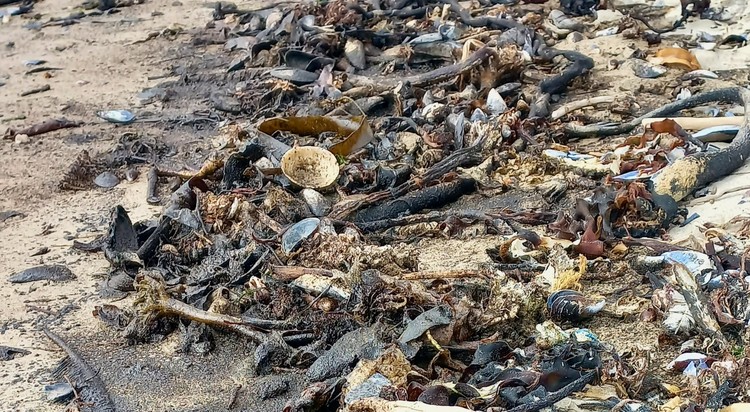
7 February 2025
Beaches along the West Coast were soiled with oil spilling from the wreck of the MV Ultra Galaxy which ran aground in July 2024. Photo: Annalize Barnard
Clean-up operations are continuing on West Coast beaches after the recent oil spill that has now been confirmed as originating from the wreck of MV Ultra Galaxy.
A workforce of some 180 people in 12 teams are cleaning beaches along a 40km section of coastline and are making “steady progress”, according to a statement by the South African Maritime Safety Association (SAMSA) this week.
The organisation said the oil had leaked during the complex wreck removal operation now underway at the Duiwegat site just south of Brand se Baai, where the stricken vessel ran aground in severe weather in July. It broke up just days later after only eight tons of bunker oil had been removed, spilling more than 500 tons of fuel and oil and a full cargo of fertiliser into the sea.
Shanghai Salvage Co, also known as China Ocean Engineering Solutions Limited, was appointed last year to undertake the wreck removal operation.
SAMSA said it had immediately activated its pollution response plan in response to the latest spill. This had included a full survey of the affected areas to assess the extent of the pollution.
Preliminary assessments indicated that the spill had several areas
•Tormin mineral sands mine: ramps 3, 4 and 7,
• small parts of the Transhex mining area,
• Robbe Eiland [Seal Island],
• Papendorp, 700m south of the mouth of the Olifants River,
• Strandfontein North: patchy coverage, and
• Strandfontein South: Kommetjie and Die Hel.
Doringbaai had been surveyed and remained clear.
“SAMSA emphasises that during operations of this nature, the risk of oil escaping is anticipated, and robust contingency measures are always in place. SpillTech, a dedicated spill management company, has been on site from the onset of the removal operation to handle such incidents promptly and effectively.”
Veteran West Coast conservationist Suzanne du Plessis, who was one of the first to alert authorities to the oil spill, said on Thursday that she was impressed by the immediate response. “The clean-up operation began within hours and the teams have been consistent.”
Easterly winds had pushed the oil slick offshore and a red tide had arrived.
“We’ll have to wait and see with the next cold front or northerly wind if there is still any oil floating around,” she said.
Cape Nature confirmed that no oiled birds had been found on the affected beaches or at the 45,000-strong Cape Gannet colony at Bird Island in nearby Lambert’s Bay – a site initially regarded as of “primary concern”. Also, the biologically critical Olifants River estuary had not been impacted.
SAMSA said that since the wreck removal operation began in December, just over 4,200 tons of material had been successfully removed from the seabed. The wreck had been transported by tug and barge for safe disposal in Saldanha Bay.
In accordance with its waste management plan, salvaged steel was processed in Cape Town. Other hazardous materials was being handled at the Vissershok hazardous waste disposal site.
Any sightings of affected wildlife or oil residue should be reported urgently to SAMSA on 021 938-3310.